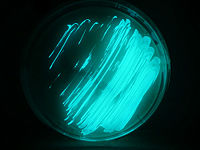Photobacterium phosphoreum
For the course duration, the article is closed to outside editing. Of course you can always leave comments on the discussion page. The anticipated date of course completion is May 21, 2009. One month after that date at the latest, this notice shall be removed. Besides, many other Citizendium articles welcome your collaboration! |
| Photobacterium phosphoreum | ||||||||||||||
|---|---|---|---|---|---|---|---|---|---|---|---|---|---|---|
 | ||||||||||||||
| Scientific classification | ||||||||||||||
| ||||||||||||||
| Binomial name | ||||||||||||||
| Photobacterium phosphoreum |
Description and significance
Photobacterium phosphoreum is a luminescent bacterium. Its physical characteristics are gram-negative, rod-like shape, plump and large (0.8-1.3 um in diameter and 1.8-2.4 um in length). It can be motile or non-motile. Those that are motile have 1-3 unsheathed polar flagella. Its optimum temperature is 18-25˚C [1]. It emits a blue-green light. It is known as a symbiotic bacterium that lives in the light organ of some marine fishes. It can also live freely in seawater, saprophytically and parasitically [2].
Its major significance is its symbiotic relationship with some marine animals like fishes and squids. They have specialized organs that provide P. phosphoreum with a safe place to reside and food; while these animals use the light that the bacteria provide for camouflage and even for attracting mates or escape from predators.
Genome structure
Cell structure and metabolism
P. phosphoreum is a chemoorganotroph which is capable of respiratory and fermentative metabolism [3]. It is a facultative anaerobe that can grow in the absence of oxygen when appropriate electron-acceptors are present. It doesn’t denitrify; in other word, it cannot use nitrogen molecules [4].
Ecology
P. phosphoreum is mostly considered a marine bacterium because sodium ions are required for its growth. It lives in the depth of the ocean, seawater, marine sediments, in the guts of marine animals, and on the surface of decomposing fish. Inside of the marine organisms, it can act as a parasite.
Application to Biotechnology
Current Research
References
http://www.ncbi.nlm.nih.gov/Taxonomy/Browser/wwwtax.cgi?id=659
http://www.microbiologyatlas.kvl.dk/biologi/english/showmorf.asp?articleid=44
http://www.disknet.com/indiana_biolab/b203.htm
http://www.biology.pl/bakterie_sw/index_en.html
http://cibt.bio.cornell.edu/programs/archive/0608alum/lumos.pdf